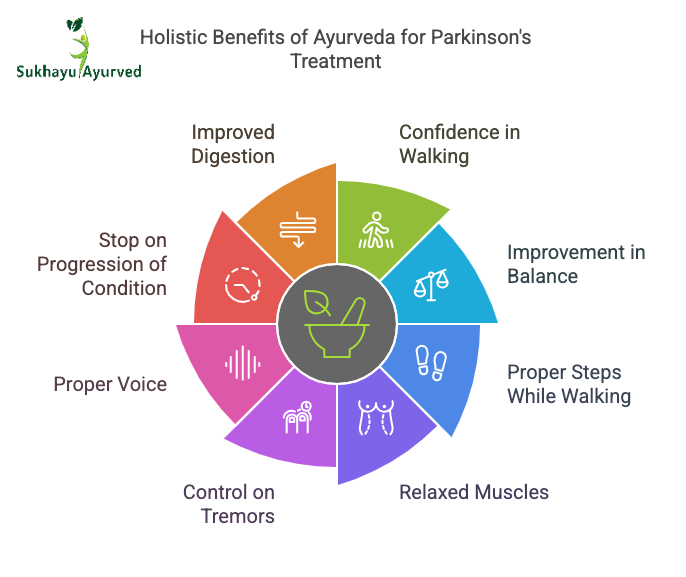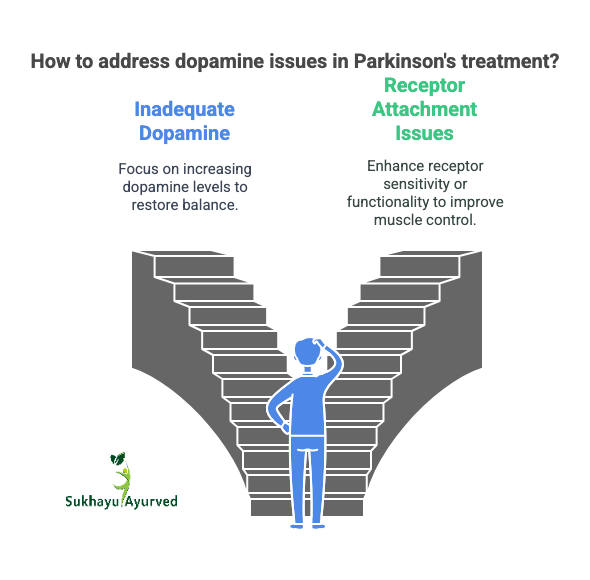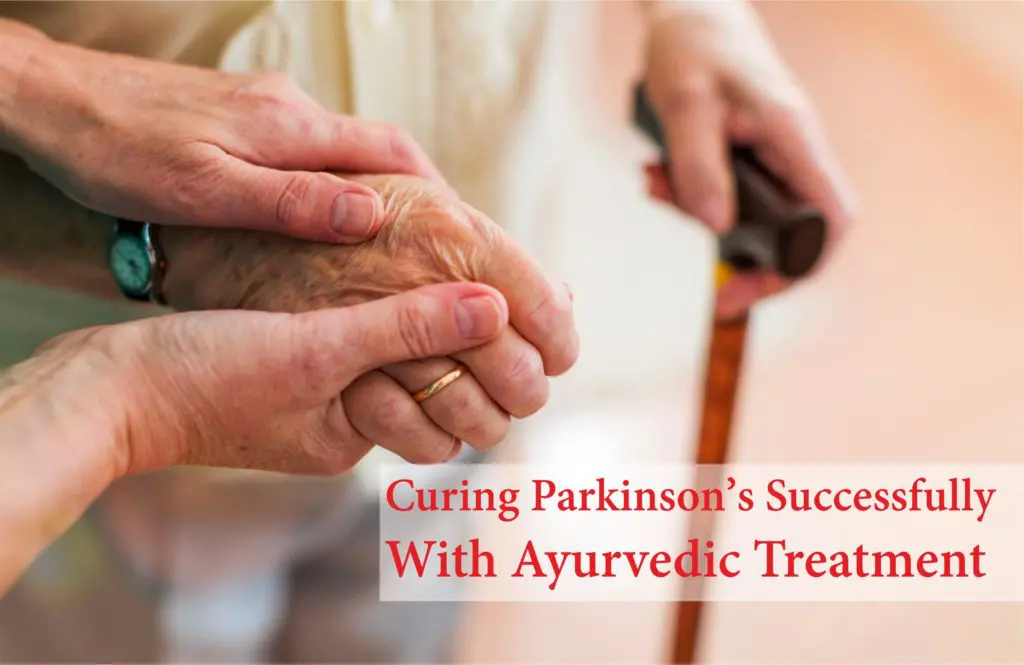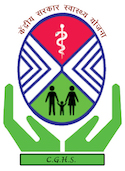How does Ayurveda treatment can help a patient of Parkinson’s Disease?
No, Ayurveda doesn’t promise. But Ayurveda ensures you –

Besides all these, at Sukhayu Ayurved we treat Parkinson’s disease to add life in your years. Under expert guidance of Vaidya Dr. Pardeep Sharma, we do this through Ayurvedic Medicines (without mucuna / Kraunc seeds and Kraunch products) and Panchakarma procedures like- Udvartana, Basti, Shirbasti, Shiropichu, Nasya, Dhoompaan and much more as per the requirement of the patient.
Treating Parkinson’s disease an Ayurveda way
Parkinson’s disease is a neurodegenerative disorder which causes problem with stability and movement. The tone of muscles decides the movement as well as stability and this tone is controlled by the brain. Within brain there are chemicals “neurotransmitters” which help in connecting different parts. Dopamines are one which are solely responsible for this control on muscles. When it is about Ayurvedic treatment of Parkinson’s disease we need to fix this dopamine part only.
There are two conditions- either brain doesn’t have adequate amount of dopamine or dopamine is not attaching to the receptors and completing the circuit inside brain. Because of these incomplete circuits brain is not able to control the muscles. This impact in two ways – Resting Tremors (when you don’t need movement body shakes) and Bradykinesia (slowness of movement).

Many Ayurveda scholars considers it as Kampavata and for this they use medicines which have natural source of Dopamine like – krauncha seeds (mucuna). Authentic Ayurvedic text doesn’t detail any disease like “kampavata” it appears as a symptom alone, not a disease. Parkinson’s disease is closer to – Kapha Aavruta Vata under Vata Vyadhi.
Dr. Pardeep Sharma M.D. (Ayurveda) is the best neurologist of Ayurveda who offers the treatment of Parkinson’s with complete Ayurveda perspective. The Kapha Aavruta Vata, condition is treated with Panchakarma procedure, because it is a complex situation. This treatment adds quality to the life of patients and help them in regaining the confidence in walking and doing daily jobs.

How does Parkinson’s Disease look (Signs and Symptoms)
As said above- there are two things alone- tremors or slowness in movements.
Tremors in parkinson’s disease mostly affect hands, neck, jaw and lower limbs also.
Bradykinesia causes – slowness in movements (baby steps), expressionless face (plastic smile), dysarthria (problem in speaking – stammering voice), dysphagia (problem in swallowing). Beside these conditions there might be problem with movement of intestines and internal organs too which can lead to – constipation too.
These symptoms are closely associate with Kapha Avrita Vata under Vata Vyadhi. Therefore we do Ayurvedic treatment of Parkinson’s disease according to this condition in Ayurveda.
Don’t forget to check: Sign and Symptoms of Parkinson’s
Ayurveda about Parkinson’s Disease
In Ayurvedic literature, the exact details of any disease is not as such available. There are certain conditions, and when we explore these conditions, we can find the treatment of many of them. Therefore in parkinsonism, the main thing is to find out the exact pathophysiology in terms of Doshas. This helps in reaching proper Ayurveda treatment and a solution to the problem.
Before we proceed to the Ayurvedic treatment for Parkinson’s disease. Here, we need to know about certain facts about PD according to Ayurveda.
- Vata is main dosha in this disease.
- Vata is not able to express itself properly.
- If we look at gunas, then we can see a clear relation between the – movement and stability (Chala and Sthira).
- Therefore we need to co-relate everything with doshas and gunas.
- The Ayurveda treatment for Parkinsons’ approach is primarily based on pathophysiology of the disease.
- Reversal of pathology helps in the complete reversal of the disease.
We at Sukhayu work on these principles only. We don’t work on lousy analogies of the diseases.
Parkinson’s Disease Versus Kampvata
The best analogy declared for Parkinson’s is Kampavata. This is not a disease as per Ayurveda. This is just a symptom. But many consider “tremors” are the only problem. Tremors seem like the main primary symptoms. But the main condition in the case of PD’s main problem is- bradykinesia- slowness in movements. And disability, hence we need to work more on the movements.
It is missed several times.
We need to bring the movements back for the patient so that his life won’t be miserable.
Consequently, the disability of a patient is all about movement. When we can restore the movement. We can help a patient better.
What Makes Parkinson’s Disease Curable in Ayurveda!
What is Parkinson’s Disease as per Ayurveda?
Here in the case of Parkinson’s, the main involved dosha is – Vata. Vata is not able to express itself. This is the basic reason behind the problem of Parkinson’s disease.
Dopamine and vata are the same. Not only dopamine, but many other biochemical activities also represent Vata dosha. Vata is not a physical thing.
This analogy stands for – activities and actions.
Because Vata itself is a very broad concept of Ayurveda. Vata is not limited to some tissue or some organ alone. The same applies to the biochemical activities of dopamine.
Dopamine works on different aspects of the body, not just in the nervous system activities. Not only confined to the brain or nervous system. So is the Vata Dosha.
When we compared the Vata and activities of dopamine, here are the points-
| DOPAMINE | VATA |
| Movement | Sarva hi chesta vaten s pranah praninam smrutah |
| Memory | Pravartakscheshtamuchchavachanam / Cheshtavegpravartanaih / Gatimatoh |
| Pleasurable reward | Niyanta Praneta Ch Mansah |
| Behavior and cognition | Sarwe-indriyarthanaambhivibhodha |
| Attention | Sarwe-indriyarnaam Udyojakah |
| Mood | Harshutsaahryoni |
This clear analogy is not by chance. There are many aspects of this. When we say, Vata disease. It means that Vata is not able to express itself.
One thing is- decay of Vata – when dopamine is not adequate in the body.
Secondly, when Vata is suppressed- dopamine is not able to attach to its receptors.
Ayurvedic Treatment of Parkinson’s Disease
The Ayurvedic treatment of Parkinson’s disease is based on two principles- Pacification of the Vata Dosha (to regenerate the dopamine production) and to remove the Avarana (to remove hinderance in action of dopamines). These two things are achieved with two fold treatment-
Shodhana (The Detoxification) through Panchakarma
The Panchakarma treatments are aimed to remove the physiological as well as pathological wastes from the body. This helps in giving the body internal environment to reproduce the dopamines. This also helps to stop the degeneration.
Also, Panchakarma treatment as part of Ayurvedic treatment of Parkinson’s disease, helps in cleansing to make sure the blockage will remove. Basti chikitsa (medication through anal route- some 3 to 5 types we do), Nasya (the nasal administration of medicine), Virechana (the medicated purgation) are few of these done internally. External procedures like – Pizhichil (the oil bath), Shirobasti (pooling oil on head) and Shirodhara (dripping oil on forehead), Shiropichu (cloth soaked with medicated oil is kept on head).
Not all Panchakarma procedures are done for every patients. Selection of these procedures is very personal.
Ayurvedic Medicines for Parkinson’s disease
There are certain medicines which assist in the process of treatment. Two categories are there, single herbs- Ashwagandha, Tagar, Jatamansi, Brahmi, Shankhpushpi are few things which help in the condition.
But at Sukhayu Ayurveda we use more classical medicines- Manas Mitra Vatakam, Brahmi Vati , Vrihat Vata Chintamani Rasa, Sarswata Ghrita, Panchagavya Ghrita, Mahakalyanaka Ghrita and many more ayurvedic medicines are there which help with treatment of Parkinson’s disease.
FAQ’s Regarding Ayurvedic Treatment of Parkinson’s Disease
There are certain frequently asked questions from patients regarding Ayurvedic treatment of Parkinson’s disease. Here we are trying to answer few of these, still you can whatsapp your query to us and we will love to answer you-
How does Ayurvedic help in treatment of Parkinson’s disease?
The main problem with neurodegenerative diseases like Parkinson’s disease is the dosages of the medicines keeps on increasing so is the disease and its complexity. You never get a chance to walk normal and you cannot get rid of the medicines.
Ayurvedic treatment of Parkinson’s disease can help you to make sure that you can lead a normal life. The main aim of the treatment is to help you for the reversal of the condition.
Can I stop my allopathy medicines immediately after starting Ayurvedic treatment of Parkinson’s disease?
The answer is yes and no!!
Yes, if you have started the allopathy medicines recently and not on the heavy dosages.
No, when you have been taking these medicines regularly since long.
It is not about leaving or stopping the medicines, it is all about quality of life and with Ayurveda treatment we aim on the same.
How much successful is Ayurveda treatment of Parkinson’s Disease at Sukhayu Ayurved Hospital?
80% + of patients are leading a normal life without any complications and symptoms and are on minimum medicines.













